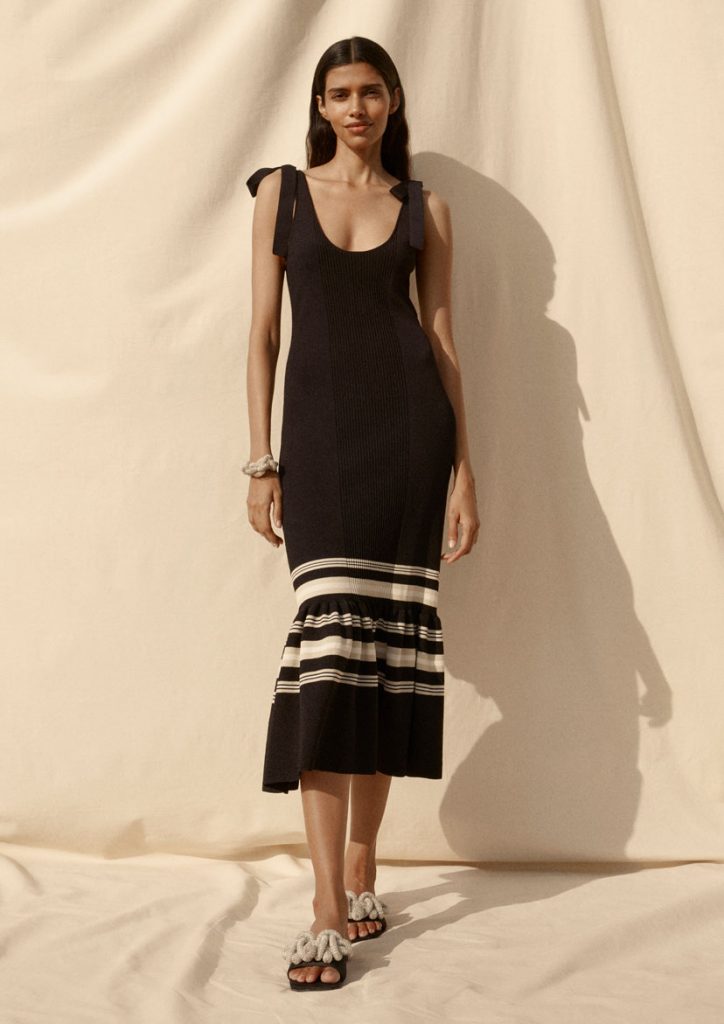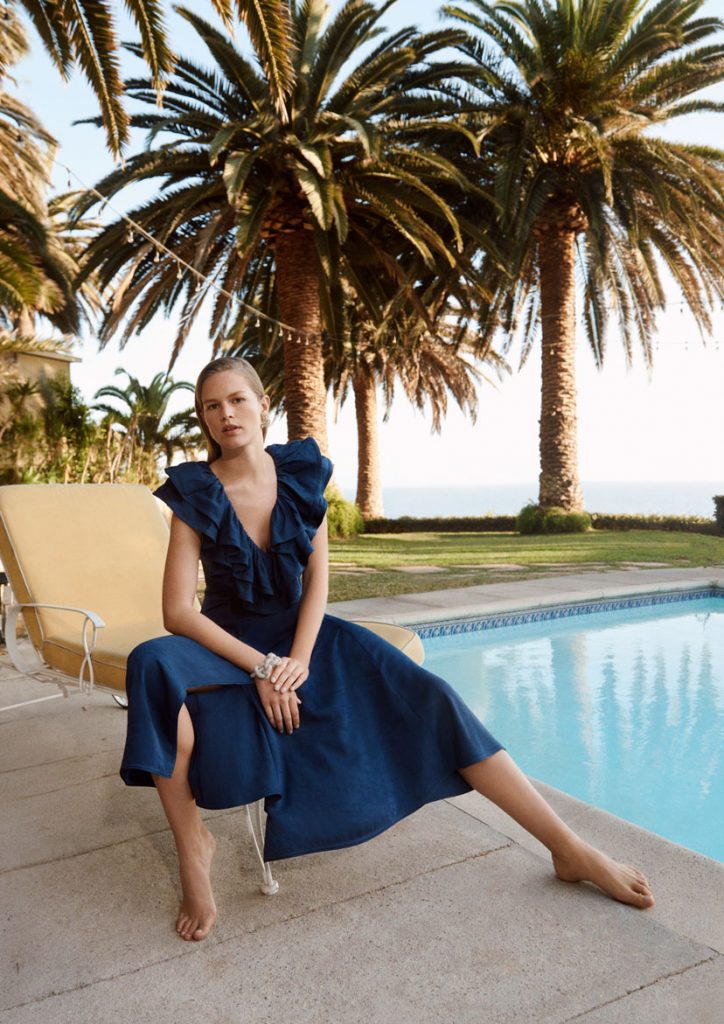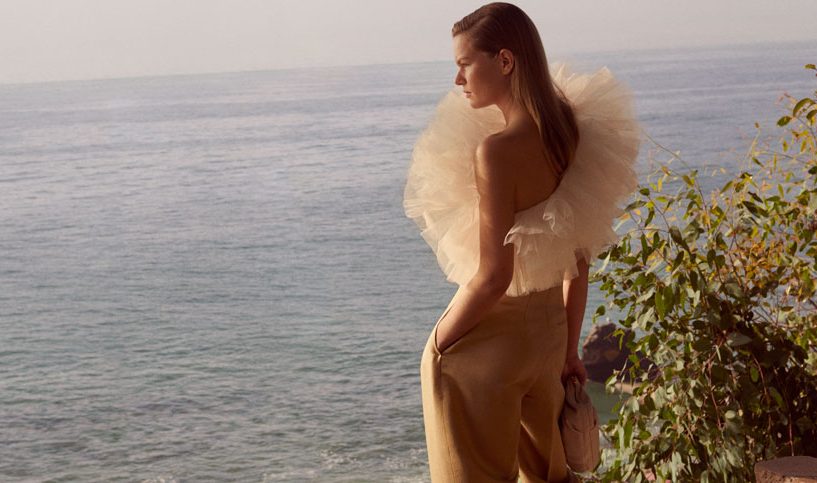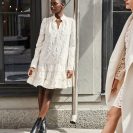Who could ever resist the glitz and glamour of the golden age of train travel? You dressed up for a cup of tea and whiled away the hours looking at spectacular views and engaged in the most sparkling conversations with fellow travelers. For H&M’s SS20 Conscious Exclusive collection, it’s all aboard Le Train Bleu, the elegant sleeper train that ran from Calais to the Côte D’Azur in France in the 1920s.
The collection brings together flamboyant evening gowns in midnight blue and sandy- hued tulle, taffeta, and silk, as well as gauzy cobalt mosaic-print day dresses. Then, there is versatile statement shirting and tailoring in shades of cream and white. The collection boasts an impressive utilization of various sustainable processes, innovative fabrications, such as VEGEAä, a vegan leather alternative, and CIRCULOSE, made of used textiles, and a circular design philosophy that promises longevity over frivolity. The SS20 Conscious Exclusive collection will be available online at kw.hm.com on March 26. Arriving as H&M’s ultimate premium womenswear collection of the most elevated pieces, Conscious Exclusive promises and delivers on a sustainable approach in both the materials used and the processes employed.
“For SS20, the Conscious Exclusive design team took a truly holistic approach to sustainability, considering the emotional durability and the afterlife of the garments in more detail than ever before. As always we have worked with some innovative materials such as CIRCULOSE, a natural material harvested from used textiles; used a natural dye made from coffee grounds collected from H&M’s own production offices. We remain committed to creating special, sustainable pieces that will truly last a lifetime,” says Ann-Sofie Johansson, creative advisor at H&M.


KEY PIECES
Riviera stripes, balletic silhouettes, and delicate ribbon embellishments conspire to create a charming and feminine collection. Key pieces include a floor-length, tiered, tulle recycled polyester ball gown; a recycled taffeta mini dress with pleated sleeves; an extravagant cold- shoulder with tulle ruffles top made of RENU, a recycled polyester made from clothes and fabrics; an easy, blue day dress with feminine ruffles made of CIRCULOSE , a natural material harvested from used textiles; a statement recycled taffeta blouse with embellished sleeves; and a relaxed linen-silk blazer with a grosgrain tie.
ACCESSORIES
Decadent coral motifs play out in recycled brass and zinc on statement earrings and cocktail rings, on padded hairbands and on delicate shoulder pieces with rhinestone clasps. Flat cocktail slippers embellished with a knot of recycled glass beads (leftover from a previous collection) are a key piece, adding wear-anywhere poise to the most flamboyant of evening gowns. Meanwhile, a grape leather belt bag with detachable straps is the ultimate in versatile arm candy.
SUSTAINABLE MATERIALS AND PROCESSES
Leftover stock fabrics from previous collections, including organic silk, recycled polyester-taffeta, and recycled glass beads make a welcome return in opulent new iterations. Also in the line-up is CIRCULOSE , a natural material produced from recycled textiles. The discarded cellulosic fibers are dissolved into pure, biodegradable pulp, then turned into new fibers, yarn, fabrics and garments. For the first time, the collection also contains denim which is made of 100 % undyed organic cotton in a fabric that is recyclable and has a lower environmental impact as its production minimizes the use of chemicals and simplifies the reusage of processed water.


Also included is RENUä, a recycled polyester made in a unique garment-to-garment process that fully closes the loop by turning clothes and textiles, which would have been thrown away, into new fabric. Then, there is VEGEAä, an innovative vegan material partly made from the by-products of winemaking, where discarded grape skins, stalks, and seeds are turned into a beautiful alternative to leather. Elsewhere, ECONYL, regenerated nylon made from discarded fishing nets; recycled brass and zinc, from pre-consumer sources such as scrap electronics and jewelry; and biodegradable Corozo buttons made from the seed of a tropical palm all feature.
“The starting point for SS20 was the notion of glamorous, stress-free train travel, specifically Le Train Bleu. We felt it was wonderfully symbolic of H&M’s magical journey as a company towards circularity. We were so inspired by the decadent creatives such as Jean Cocteau and Pablo Picasso who were hanging out at Villa Santo Sospir, the socialite Francine Weisweiller’s beautiful home in Cap Ferrat. We wanted to design clothes that mimicked that carefree time and that will still prove poetic in years to come – to us, that’s the definition of sustainable design,” says Ella Soccorsi, designer at H&M.
We spoke further with H&M’s head of sustainability, Pascal Brun, to learn more about the special SS20 Conscious Exclusive collection:

Hi Pascal, tell us more about your role as Head of Sustainability at H&M.
I have a very multi-faceted and fast-paced role at H&M which means I oversee all our sustainability activity across the business and make sure that our sustainability goals are integrated into our business proposition, which is: “Fashion and quality at the best price in a sustainable way.” This is quite a broad remit which means I am looking at everything from the sourcing of sustainable materials, to making sure we have the right tools in place to contribute to fair jobs and fair wages along the supply chain, as well as collaborating with strong partners to set high environmental standards. We set ourselves really ambitious goals, such as becoming climate-positive by 2040. I find the daily challenges very fulfilling!
It seems that H&M comes up with an innovative sustainable material every year – can you tell us more about the research that goes into developing these materials?
We have a brilliant production team that is always looking out for exciting innovations and we work with a lot of great partners, innovators, and scientists worldwide, who make these constant developments possible. We keep tabs on things over a period of years so that once it has hit a scalable level, and guarantees the high quality we demand at H&M, we can utilize it in our collections. VEGEAä, for instance, which is a vegan leather alternative made from the waste products of the wine industry, originated with the Global Change Award which was initiated by the H&M Foundation – and it’s now being used in our SS20 Conscious Exclusive collection. Another example from this year’s collection is Circulose®, a natural material produced from recycled textiles. It’s pioneered and produced by re:newcell – a company H&M Group has proudly supported since its start.
What is different about the sustainable materials used in the SS20 Conscious Exclusive collection?
We’ve got some really exciting materials in this SS20 collection. I’m proud to say, that this Conscious Exclusive collection is filled with innovative materials that the rest of the industry could benefit from using, such as RENUä, a closed-loop recycled polyester. Another very interesting example is the natural dye made from coffee grounds from our Shanghai office which is being used to give a camisole top a pale mushroom shade. And we’ve used leftover glass beads from a previous collection for accessories, too. Conscious Exclusive is a testbed for new innovations and sustainably sourced materials, that we introduce with these collections but that will hopefully be scalable in the future. Already today 57% of the material used in our collections comes from sustainable sources and we are committed to reaching 100% by 2030.
What are H&M’s future sustainability plans? Do you see the CE approach applied to all of H&M production operations?
I think we all agree that we need to change the way fashion is designed, developed, produced, consumed and disposed of today. Let’s change fashion – together! We, as a global fashion company, have a big responsibility but at the same time the power, to lead this change. As for the future of sustainability at H&M, we have many exciting plans: I’m thrilled that now in 2020 we hit our sustainably sourced cotton target, all of our cotton is now either organic, recycled or sourced through the Better Cotton Initiative (BCI), a non-profit organization that works directly with farmers. By 2030 we aim to achieve 100 percent sustainably sourced materials across the business. And by 2040, as I mentioned, we aim to become climate positive. There’s a lot of work to do, but I’m confident we can achieve our goals if we work together.
Shop the SS20 Conscious Exclusive collection at www.kw.hm.com from March 26. All images courtesy of H&M.











